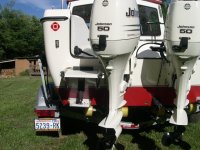Is it possible to mount twin 40's on a CD22 far enough apart to fit a swim ladder in between? I'm guessing there would be a steering control rod that you would have to step over?
I will be single-handing the great loop and would like as much motor control as possible. So I thought if I could separate the motors, even with a custom bracket system, that would allow using the motors to steer in awkward places.
I will be single-handing the great loop and would like as much motor control as possible. So I thought if I could separate the motors, even with a custom bracket system, that would allow using the motors to steer in awkward places.

